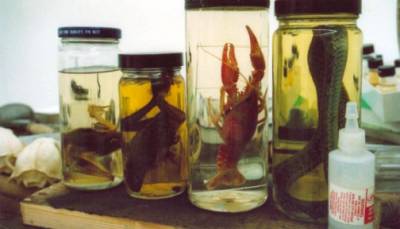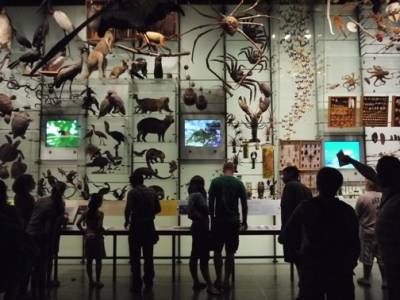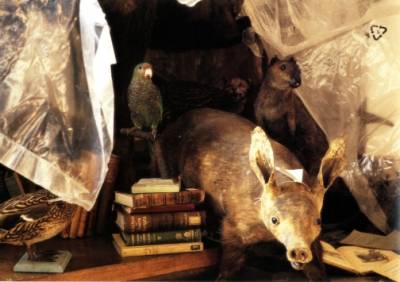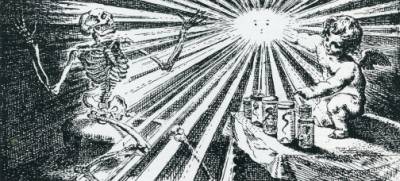
AHRC Research Network directed by Petra Lange-Berndt and Mechthild Fend
Prepared specimens appear in many guises: as monstrous or typical organs preserved in formaldehyde and kept in glass jars not unlike pickled food, as stained and fixed tissue slices, or as skilfully arranged mounted animals. They may be found in cabinets of curiosities, in the laboratories of histologists, in anatomy theatres or in natural history collections, but nowadays equally in art galleries, the shop windows of fashionable boutiques, or horror films. This research network is concerned with such kinds of preserved natural objects, in particular with anatomical wet or dry preparations and taxidermy. It explores the hybrid status of these objects between nature and representation, art and science and studies their fabrication, history and display.
The network is a collaboration between the UCL Department of History of Art, UCL collections, in particular the Grant Museum of Zoology, the Hunterian Museum, London and the Natural History Museum, London.
Activating Stilled Lives.
The Aesthetics and Politics of Specimens on Display
International conference at the Department of History of Art, UCL
Thursday 17 May - Friday 18 May 2012

Hall of Biodiversity,
American Museum of Natural History, New York 2011
Previous events
Workshop 1:
Taxidermy-Animal Skin and Colonial Practice
Workshop in collaboration with the Natural History Museum, London
12-14 May 2011

Mark Dion: An Account of Six Disastrous Years in the
Library for Animals (detail), Installation at the Centrum Sztuki Wspólczesnej,
Zamek Ujazdowski, Warsaw 1992
This first workshop, conceptualised by Petra Lange-Berndt and carried out in collaboration with Bergit Arends (Curator
Contemporary Art, NHM), focused on power relations inherent in
taxidermy, the preservation of animal hides. The precondition of the
seeming lifelikeness of mounted specimens is the attempt to hide the
work of the taxidermist and thus to preclude the fact that we are
actually dealing with a dead animal. But more importantly this event
investigated how the artful arrangement of skin is linked to narratives
of imperialism and colonial supremacy, to notions of "exploration",
"discovery", and "classification". We discussed the many processes of
making taxidermy and its intermediality as well as its institutional
display or the impact of emerging ecological theories. Special
attention was paid to the role artists have been playing since the
beginning of the twentieth century in calling attention to the
aesthetics and politics of natural history collections. Therefore,
contemporary strategies that question histories and formulate
alternatives to practices associated with them-such as vegan
taxidermy-as well as issues of zoological curation, display and
conservation were considered. Areas for further discussion are clearly
the missing social history of the taxidermist, to counter a European
and North-American perspective by considering a broader range of
institutions around the world, the management of decay within
collections, ways of making uncomfortable objects public, and the
unease encountered by considering the use of taxidermy and other animal
remains in applied arts such as trophy furniture.
Keynote: Mark Dion (Visual Artist, USA): "My Taxidermy Taxonomy"
Participants: Sam Alberti (Director, Hunterian Museum, London), Bergit Arends (Curator Contemporary Art, The Natural History Museum, London), Mark Dion (Visual Artist, USA), Tessa Farmer (Artist, London), Derek Frampton (Taxidermist, Tring), Sebastian Hackenschmidt (Curator and Custodian for Wood and Furniture, Museum of Applied Arts / Contemporary Art, Vienna), Petra Lange-Berndt (Lecturer, Department of History of Art, UCL), Richard Sabin (Senior Curator, Department of Zoology, The Natural History Museum, London), Hanna Rose Shell (Filmmaker, Historian and Media Scholar, MIT, Harvard University), Robert Williams (Artist, Lancaster), Bryndis Snæbjörnsdóttir / Mark Wilson (Artists, Bewcastle)
Workshop 2:
Wet-Preparations: Anatomy, Pathology and the Body Contained
Workshop in collaboration with the Hunterian Museum, London
9-11 June 2011

C. H. Huyberts: Frontispiece to Frederik Ruysch's Icon duraematrix, Amsterdam 1738
The workshop conceived by Mechthild Fend and carried out in
collaboration with Sam Alberti
(Hunterian Museum) focused on anatomical and pathological preparations, and
predominantly wet-preparations. The shared agenda was to look at historically
shifting attitudes towards the preservation and subsequent display of human
body parts that were not always ranged in the ethical and pseudo-religious
category of 'human remains' as expressed among others in the many historical
debates of the pros and cons of preserved specimen versus wax or papier maché
models. The workshop looked at the transformations the body of a formerly
living person undergoes when it is turned into segments that are arranged and
prepared, and eventually becomes a preserved specimen, and considered the
further fate of such specimens as well as their handling, display and
conservation in private or public medical collections. It considered dissection
(the singling out, cutting up and hence making of body parts) as an initial
step in the making of preservations, which were not necessarily meant to last
forever, but at times decay was only delayed for shorter periods, in order for
arranged body parts to be retained by a draughtsman or studied by students.
Once in a container, specimens are not only preserved for visual inspection,
but also to be taken out of their jars, handled and re-examined. A further
issue was the unease prompted (at least today) by parts of the human body
prepared for purposes other than medial research and teaching, such as human
skin flayed and tanned for bookbinding. Finally, a question raised by practices
of curating and conservation is what constitutes the specimen a museum object
and collectible historical item (rather than an object of medical research) -
the organic material only, the liquid, the jar? Do different ethics apply to
these materials and which of these elements can and should be preserved today?
An issue to be further discussion will be the ethics of the preservation or
disposal, the use and display of preserved specimens today.
Keynote: Nick Hopwood (Historian of Science, University of Cambridge): "Preserved Embryos"
Speakers: Samuel Alberti (Director of Museums and Archives, The Royal College of Surgeons of England), Gemma Angel (PhD candidate, UCL History of Art), Mechthild Fend, Hieke Huistra (PhD
candidate in the History of Medicine at the Institute for Cultural Disciplines
at Leiden University), Anna Maerker (Senior lecturer,
Department of History, Kings College, London), Andries van Dam (Conservator, Anatomy Museum at Leiden University
Medial Centre and Scientific Collection Manager, Netherlands Centre for
Biodiversity, Naturalis)
 Close
Close

